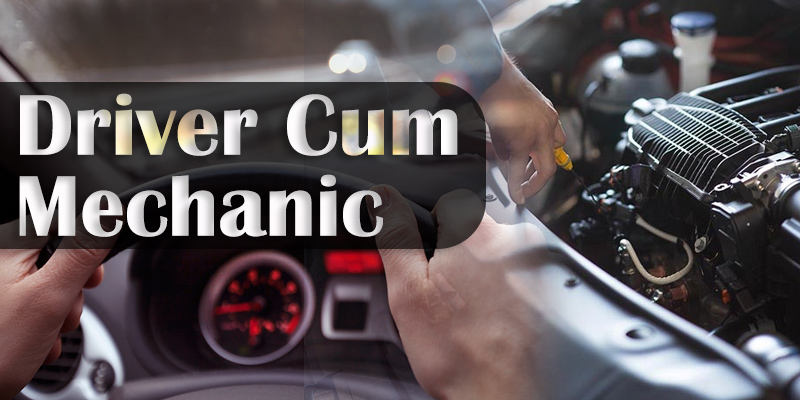
ITI Driver Cum Mechanic (Light Motor Vehicle) Trade Syllabus
The ITI "Driver Cum Mechanic (Light Motor Vehicle)" trade is a six-month vocational training program under the Craftsman Training Scheme (CTS), governed by the National Council for Vocational Training (NCVT). This course equips trainees with the skills to drive light motor vehicles safely and perform basic maintenance and repairs under supervision, ensuring vehicle availability for official or personal use. The syllabus integrates theoretical knowledge, practical skills, and employability training to prepare students for roles such as drivers, assistant mechanics, or fleet support staff in government and private sectors.
Course Overview
- Duration: 6 months (1 semester)
- NSQF Level: Level 3
- Eligibility: Minimum 10th grade pass from a recognized board; minimum age of 18 years
- Objective: To train individuals to drive light motor vehicles safely on various terrains and perform basic servicing and troubleshooting, adhering to traffic regulations and safety standards.
Detailed Syllabus Breakdown (English)
1. Trade Theory (Theoretical Knowledge)
Covers the foundational knowledge required for driving and maintaining light motor vehicles.
- Introduction to the Trade
- Importance of light motor vehicles in transportation and industry.
- Roles and responsibilities of a Driver Cum Mechanic.
- Overview of vehicle types: cars, jeeps, light vans.
- Road Safety and Traffic Regulations
- Traffic rules and road signs as per the Motor Vehicles Act.
- Safe driving practices: speed limits, overtaking, lane discipline.
- Road safety measures: use of seat belts, helmets, and defensive driving techniques.
- Vehicle Construction and Systems
- Basic construction of light motor vehicles: chassis, body, engine types (petrol, diesel).
- Major systems: engine, transmission, steering, suspension, brakes, electrical system.
- Fuel systems: petrol, diesel, CNG, LPG kits – components and functioning.
- Basic Maintenance and Repair
- Pre-operational checks: oil levels, tire pressure, coolant, battery.
- Lubrication: types of lubricants, greasing points, oil change procedures.
- Tools and equipment: identification and use of basic hand tools (spanners, jacks, screwdrivers).
- Occupational Safety and Health
- Safety precautions while driving and working on vehicles (e.g., avoiding burns, electrical shocks).
- Handling of fuels and hazardous materials.
- First aid for road accidents and minor injuries.
2. Trade Practical (Hands-On Skills)
Focuses on developing practical expertise in driving and basic vehicle maintenance.
- Driving Practice
- Familiarization with vehicle controls: clutch, brake, accelerator, gears, steering.
- Driving on straight roads, curves, and slopes; reversing and parking practice.
- Driving in different conditions: urban traffic, highways, wet surfaces, sandy terrains.
- Overtaking, lane changing, and adhering to traffic signals.
- Vehicle Inspection and Maintenance
- Pre-driving checks: inspecting tires, brakes, lights, and fuel levels.
- Cleaning and washing vehicles: exterior and engine bay.
- Lubrication tasks: applying grease, changing engine oil, checking fluid levels.
- Basic Repairs
- Assisting in minor repairs under supervision: tightening loose parts, replacing fuses, bulbs.
- Jacking up vehicles and changing tires; wheel alignment basics.
- Battery maintenance: checking terminals, topping up distilled water.
- Project Work
- Performing a complete pre-trip inspection and documenting findings.
- Driving a designated route and reporting vehicle performance.
- Basic servicing of a light motor vehicle under supervision.
3. Workshop Calculation and Science
Provides mathematical and scientific foundations for vehicle-related tasks.
- Basic arithmetic: addition, subtraction, multiplication, division for fuel and maintenance calculations.
- Units of measurement: pressure (psi), volume (liters), distance (km).
- Basics of mechanics: force, friction, torque, and their relevance to driving and repairs.
- Fuel efficiency calculations: mileage per liter, cost estimation.
4. Engineering Drawing
Teaches basic technical drawing for understanding vehicle components.
- Use of drawing tools: ruler, compass, pencil.
- Simple sketches of vehicle parts: engine, wheels, brakes.
- Reading basic vehicle layout diagrams and symbols.
5. Employability Skills
Enhances job readiness and soft skills.
- Communication skills: interacting with supervisors, passengers, and mechanics.
- Time management: planning driving schedules and maintenance tasks.
- Basic IT skills: using digital logbooks or GPS systems.
- Entrepreneurship: opportunities in taxi services or small repair shops.
Assessment and Certification
- Examinations: Conducted at the end of the semester, including theoretical and practical tests.
- Certification: Successful candidates receive the National Trade Certificate (NTC) from NCVT, recognized nationally and internationally.
- Evaluation: Based on driving tests, practical maintenance tasks, written exams, and project work.
Career Opportunities
- Employment: Driver in government/private offices, assistant mechanic in workshops, fleet maintenance staff.
- Self-Employment: Taxi operator, vehicle rental business, small-scale repair shop, driving instructor.
- Further Studies: Advanced courses like Mechanic (Motor Vehicle) or diploma in automobile engineering.
Note
- This syllabus aligns with the latest NCVT guidelines and may vary slightly based on institutional or state-specific requirements.
- For the most current version, refer to the Directorate General of Training (DGT) website (dgt.gov.in) or consult your local ITI.
Trade Type
- 27 views